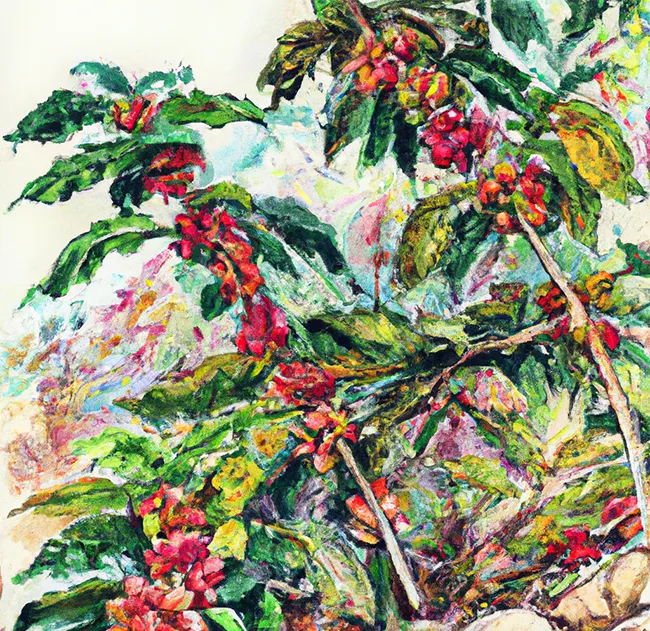 | ||
| Javanese coffee watercolor painting. by See Coffees |
Unraveling the Mystery of Java Coffee Seeds
Have you ever wondered where the seeds of
the coffee beans that now thrive in coffee plantations worldwide, including
major coffee-producing nations like Central and South America, and the
Caribbean Islands, including Mexico, actually originated from? Is it true that
these seeds trace their roots back to Java Island? Let's explore some
historical facts.
In an interview conducted by Tempo
journalist with Prawoto Indarto, the author of "The Road to Java
Coffee," at the Jagongan Ngopi Neng Solo event in Pasar Gede, Surakarta
City, on September 30, 2016, it was revealed that since 1726, Java coffee had
already surpassed the dominance of Mocha coffee in the European market. It's
worth noting that in that period, approximately 90 percent of the coffee,
equivalent to 2,145 tons, auctioned in Amsterdam originated from Java Island.
The history of Java coffee dates back to as
early as 1618. According to data from the Coffee & Cacao Trade Journal
(1964:29), cited by Prawoto, in that year, the Dutch East Indies Company
obtained permission from the Ottoman Empire in Turkey to establish branches in
the cities of Aden and Mocha, a bustling port city in Yemen.
During the mid-15th to 16th centuries,
coffee primarily thrived in the Arabian Peninsula. By establishing branches in
Mocha, the Netherlands became exporters of coffee to various countries in Asia
and Europe.
Trade competition was fierce at the time.
To break the monopoly held by Arab traders in the coffee trade, the Dutch began
cultivating coffee in regions beyond Mocha.
Mayor of Amsterdam, Nicholas Witsen, played
an active role in this endeavor. In 1696, Witsen ordered the VOC forces to
acquire Coffea arabica seeds from the Malabar Coast, India, for cultivation in
Java. These coffee seeds were reportedly planted in areas like Kampung Melayu,
Bifara Cina (Bidaracina), Maester Cornelis (Jatinegara), Palmerah, Sukabumi,
and Sudimara.
Botanists from Amsterdam were also brought
into the effort. In 1706, these botanists conducted extensive research and
analysis, revealing that the coffee cultivated on Java Island possessed
top-tier quality.
As a result, it was recommended that the
Java coffee seeds be propagated and distributed to botanical gardens across
Europe, including being sent to King Louis XIV of France. From then on, Java
coffee seeds were officially transported to Martinique, a French colony in the
Caribbean Islands, through the Royal Jardine de Plantes Botanical Garden.
It was from Martinique, as stated by
Prawoto, that the coffee seeds from Java eventually spread, becoming the
initial seeds of Coffea arabica planted in various coffee plantations in
coffee-producing nations around the world.
"In 1711, Java coffee broke the
highest price at the Amsterdam Auction House," as Parwoto stated, as
quoted by Tempo.
The Global Impact of Java Coffee
The introduction of Java coffee to the
global market marked a significant turning point in the history of coffee
production. Its exceptional quality and unique flavor profile quickly gained
favor among coffee connoisseurs worldwide. As a result, Java coffee seeds
became the cornerstone of coffee cultivation in various coffee-producing
nations, shaping the diverse array of flavors and profiles that coffee
enthusiasts cherish today.
Pioneering Techniques in Coffee Cultivation
The cultivation of Java coffee brought
forth pioneering techniques and practices that revolutionized the coffee
industry. The meticulous care taken in selecting the finest coffee cherries,
coupled with the unique fermentation process within the digestive tract of the
civet, set a new standard for excellence in coffee production. These practices
continue to inspire modern coffee growers to innovate and refine their methods,
striving for the perfect cup of coffee.
A Testament to the Interplay of Nature and Human Ingenuity
The story of Java coffee exemplifies the
delicate interplay between nature's bounty and human ingenuity. Through
strategic initiatives and a deep understanding of botany, the Dutch pioneers
were able to harness the potential of Coffea arabica, resulting in a coffee
variety that would leave an indelible mark on the global coffee industry.
Resilience and Adaptability
Over the centuries, Java coffee has
weathered various challenges, from shifts in market demand to changes in
agricultural practices. Yet, its legacy endures as a testament to the
resilience of coffee cultivation and the enduring appeal of its unique flavor
profile. Today, coffee enthusiasts continue to seek out Java coffee, drawn by
its rich history and unparalleled taste.
Preserving a Legacy
As the coffee industry continues to evolve,
preserving the legacy of Java coffee becomes paramount. Ethical sourcing and
sustainable practices ensure that this extraordinary variety of coffee
continues to thrive, while also safeguarding the habitats of the civets that
play a vital role in its production. By supporting producers who prioritize
these values, coffee lovers contribute to the preservation of a centuries-old
tradition.
In conclusion, the journey of Java coffee
from the shores of Indonesia to coffee plantations worldwide is a testament to
the enduring allure of this exceptional variety. Its rich history, intertwined
with the craftsmanship of dedicated coffee growers, has left an indelible mark
on the global coffee industry. For those who seek a truly unique and storied
coffee experience, Java coffee remains a beacon of quality and tradition,
inviting us to savor the remarkable flavors that have captivated coffee lovers
for centuries.



.webp)



.webp)

